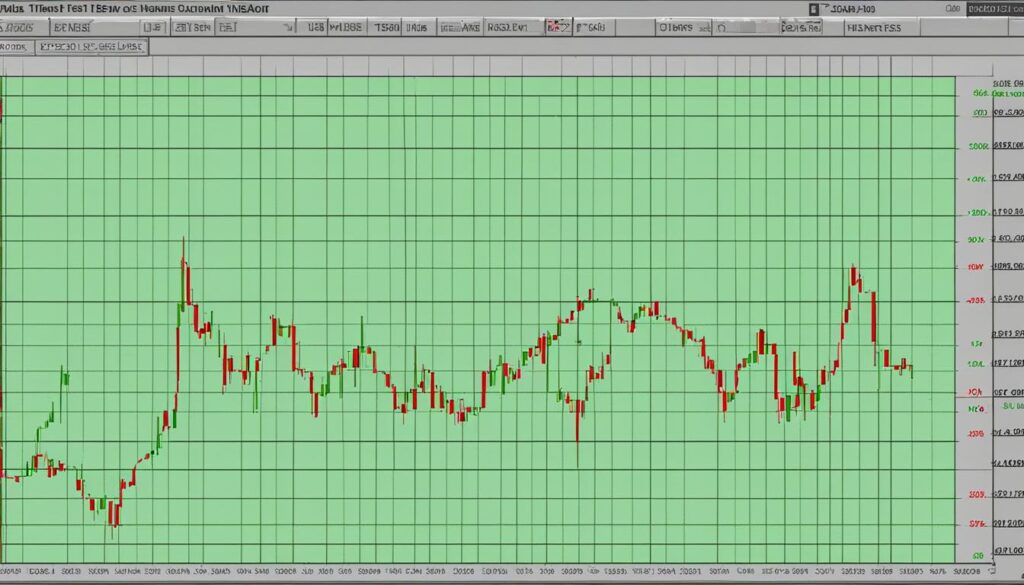Welcome to my guide on Futures Trading! If you’re interested in delving into the exciting world of the commodity market, it’s crucial to grasp the fundamentals of futures trading. This investment strategy involves the buying or selling of futures contracts for commodities or assets at a predetermined price and date. While potentially rewarding, futures trading carries inherent risks that necessitate a thorough understanding of the market and its intricacies. Let’s dive in and explore the key aspects of futures trading in the commodity market.
Key Takeaways:
- Futures trading involves buying or selling futures contracts for commodities or assets at a predetermined price and date.
- Understanding the mechanics of futures contracts and their associated risks is essential before entering the commodity market.
- Futures contracts have standardized sizes, tick sizes, and trading hours, and can be settled through physical or financial means.
- Margin and leverage play a significant role in futures trading, allowing traders to control large contract values with minimal capital.
- Expiration dates and delivery processes are important considerations, with most traders opting to offset their positions before expiration.
Understanding Futures Contracts
In the world of finance, futures contracts play a crucial role as a widely used financial instrument. These contracts involve an agreement to buy or sell a specific quantity of a commodity or asset at a future date and predetermined price. Understanding the mechanics of futures contracts is essential for anyone venturing into futures trading.
Every futures contract has certain key attributes that make it a standardized size and facilitate trading. The tick size represents the minimum price movement allowed for a contract, ensuring accurate price discovery and efficient trading. Additionally, each contract has specified trading hours, which determine when buying and selling can take place.
Settlement of futures contracts can occur either through physical delivery or financially. Physical delivery entails the transfer of the underlying commodity or asset from the seller to the buyer upon contract expiration. Conversely, financial settlement involves the payment or receipt of the price difference between the contract price and the market price at expiration.
Understanding the delivery process in futures trading is vital to navigate the market effectively. Traders must grasp the intricacies of delivery mechanisms to align their trading strategies and risk management practices accordingly.
Margin and Leverage in Futures Trading
When it comes to futures trading, understanding margin and leverage is crucial for success. Margin refers to the initial deposit required to enter a futures trade. It represents a small percentage of the total contract value and acts as a form of collateral for the trader. Leverage, on the other hand, allows traders to control a larger value of contracts with only a fraction of the capital required.
By utilizing leverage, traders can potentially amplify their gains. For example, if a trader has a leverage ratio of 1:10, they can control contracts worth ten times their initial margin. This can be highly beneficial in capturing larger profits from market movements.
However, it’s important to understand that leverage also magnifies losses. If the market moves against a trader’s position, losses can accumulate quickly. That’s why it’s crucial to manage risk and set proper stop-loss orders.
Traders must also be aware of two important concepts related to margin: initial margin and maintenance margin. The initial margin is the required deposit needed to enter a trade, while the maintenance margin is the minimum account balance that traders must maintain to keep the positions open.
If the account balance falls below the maintenance margin level, a margin call may be issued. A margin call is a demand from the broker for additional funds to cover potential losses and maintain the required margin. Failing to meet a margin call can result in the broker closing out positions, potentially causing further losses.
Understanding Margin and Leverage: An Example
Let’s say a trader wants to enter a futures contract for a particular commodity with a total contract value of $10,000. The exchange sets the initial margin requirement at 5% and the maintenance margin at 3%.
The trader would need an initial margin of $500 ($10,000 x 5%) to enter the trade. As long as the account balance stays above the maintenance margin of $300 ($10,000 x 3%), the position remains open. However, if the account balance falls below $300, a margin call would be issued, requiring the trader to replenish the account to meet the maintenance margin level.
Managing margin and leverage effectively is essential for protecting capital and avoiding unnecessary losses in futures trading. Traders should carefully assess their risk tolerance and develop appropriate risk management strategies to navigate the volatility of the futures market.
“Leverage is a powerful tool that can amplify gains in futures trading, but it can also lead to substantial losses. Margin calls can catch traders off guard, so it’s crucial to monitor account balances and keep sufficient funds to cover maintenance margins.”
Expiration and Delivery in Futures Trading
In futures trading, understanding the concept of expiration and delivery is crucial for traders. Let’s explore how expiration works and the different methods of settling futures contracts.
Expiration Dates
Every futures contract has an expiration date, which is the last day on which the contract can be traded. Once the expiration date is reached, the contract becomes invalid, and no further trading can take place.
“The expiration date marks the end of the contract’s validity and signifies the need for traders to take appropriate actions.”
Settlement Methods
When a futures contract reaches its expiration date, it can be settled through two main methods: physical delivery or offsetting the position.
Physical delivery refers to the exchange of the underlying asset or commodity between the buyer and seller of the futures contract.
Offsetting a position, on the other hand, involves taking an opposite position to the original contract before its expiration date. This allows traders to close out the contract without physically taking or delivering the underlying asset.
“Most traders prefer to offset their positions before expiration to avoid the complexities and costs associated with physical delivery.”
The Clearinghouse as the Counterparty
In futures trading, the counterparty in a transaction is the entity that takes the opposite side of the trade. In the case of futures contracts, the counterparty is the clearinghouse.
The clearinghouse acts as an intermediary, facilitating the clearing and holding of contracts. It ensures the smooth settlement of trades and minimizes counterparty risk.
By acting as the counterparty, the clearinghouse enhances the efficiency and integrity of the futures market.
Understanding the expiration and delivery process is essential for successful futures trading. Whether traders choose to offset their positions or undergo physical delivery, being aware of these aspects enables them to make informed decisions and manage their risk effectively.
Trading Symbols and Price Quotes in Futures Trading
When entering the exciting world of futures trading, it is essential to understand the symbols and price quotes associated with different commodities or assets. Each product in the futures market has its own unique symbol, which serves as a shorthand identifier for trading purposes. These symbols act as a standardized system that allows traders to easily identify and trade specific contracts.
Price quotes in futures trading can be different from traditional decimal quotes used in other financial markets. Instead, futures prices are quoted in terms of ticks, which represent the minimum price movement allowed for a particular contract. For example, if a futures contract has a tick size of $0.01, the price may be quoted as 100.00, 100.01, 100.02, and so on.
The tick size and value can vary depending on the contract specifications. Traders need to be aware of these details to accurately interpret price quotes and calculate potential profits or losses. It is advisable to consult the specific exchange’s rules and contract specifications for precise tick sizes and tick values.
Note: Futures price quotes are represented in ticks, not decimals. It is important to understand the tick size and value of each contract to accurately interpret the price quotes.
Monitoring volume and open interest is crucial for futures traders. Volume represents the total number of contracts traded within a specific period, indicating the level of market activity. Higher volume often suggests greater liquidity and can be beneficial for executing trades efficiently.
Open interest, on the other hand, refers to the total number of outstanding contracts that have not been offset or fulfilled by delivery. It provides insight into the market’s overall interest in a particular contract. Increasing open interest suggests new participation or additional positions being taken, which can indicate market sentiment or potential price trends.
Understanding and analyzing volume and open interest alongside price quotes can provide valuable insights into market dynamics, helping traders make informed decisions based on market trends and liquidity.
| Symbol | Sample Price Quote | Volume | Open Interest |
|---|---|---|---|
| CL | 67.85 | 10,000 | 50,000 |
| ZC | 408.75 | 5,000 | 25,000 |
| GC | 1,815.50 | 2,500 | 20,000 |
Note: The above table illustrates sample trading symbols, price quotes, volume, and open interest. Please refer to the respective commodity exchange or broker for real-time and accurate information.
By gaining a deep understanding of trading symbols, price quotes, volume, and open interest, futures traders can navigate the markets with confidence and make informed trading decisions based on market trends and liquidity.
Conclusion
Futures trading in the commodity market offers tremendous potential for investors seeking lucrative investment strategies. However, it is crucial to recognize and manage the inherent risks involved in this dynamic market. Before venturing into futures trading, it is essential to develop a deep understanding of the mechanics of futures contracts and their associated risks.
To maximize the chances of success, traders should diligently research and analyze market conditions, staying informed about the latest trends, news, and factors influencing commodity prices. Additionally, it is crucial to develop effective trading strategies that align with personal risk tolerance and investment goals. This can involve a combination of technical analysis, fundamental analysis, and risk management techniques.
Furthermore, it is recommended to keep a close eye on market trends, monitor price fluctuations, and utilize tools and indicators to make informed trading decisions. Having a disciplined approach and managing emotions is key to navigating the volatile nature of futures trading in the commodity market.
In summary, while futures trading presents lucrative opportunities, traders must exercise caution, conduct thorough research, and continuously adapt their strategies to the dynamic commodity market. By understanding the risks and implementing effective trading plans, individuals can position themselves for success and potentially capitalize on the vast potential of futures trading.
FAQ
What is futures trading?
Futures trading is a risky investment strategy that involves buying or selling futures contracts for commodities or assets at a predetermined price and date.
What is a futures contract?
A futures contract is an agreement to buy or sell a specific quantity of a commodity or asset at a future date and price. Each futures contract has a standardized size, tick size, and trading hours.
How are futures contracts settled?
Futures contracts can be settled physically or financially, and understanding the delivery process is essential.
What is margin and leverage in futures trading?
Margin is the initial deposit required to enter a futures trade and represents a small percentage of the total contract value. Leverage allows traders to control a large value of contracts with a relatively small amount of capital. However, leverage can result in significant gains or losses, and margin calls may be issued when the account doesn’t have enough cash to cover maintenance margin.
What happens when a futures contract expires?
Futures contracts have expiration dates, and they can be settled through physical delivery or offsetting the position. Most traders choose to offset their positions before expiration to avoid physical delivery.
Who is the counterparty in a futures trade?
The counterparty in a futures trade is the clearinghouse, which facilitates the clearing and holding of contracts.
How do I understand symbols and price quotes in futures trading?
Each commodity or asset in the futures market has its own symbol, and understanding the symbols is crucial for trading. Price quotes in futures trading can be different from traditional decimal quotes and vary based on the contract specifications.
What are volume and open interest in futures trading?
Volume and open interest are important indicators of market activity and liquidity.
Is futures trading in the commodity market risky?
Yes, futures trading in the commodity market can be a lucrative investment strategy, but it comes with significant risks. Traders should thoroughly understand the mechanics of futures contracts and the associated risks before entering the market.
What are the key factors to successful futures trading in the commodity market?
Developing effective trading strategies and staying informed about market conditions are key to successful futures trading in the commodity market.
Source Links
- https://www.e-futures.com/futures-trading-101.php
- https://www.tdameritrade.com/retail-en_us/resources/pdf/TDA101281.pdf
- https://rjofutures.rjobrien.com/introduction-to-futures-trading/futures-trading-101
Disclaimer
All information on this website is of a general nature. The information is not adapted to conditions that are specific to your person or entity. The information provided can not be considered as personal, professional or legal advice or investment advice to the user.
This website and all information is intended for educational purposes only and does not give financial advice. Signal Mastermind Signals is not a service to provide legal and financial advice; any information provided here is only the personal opinion of the author (not advice or financial advice in any sense, and in the sense of any act, ordinance or law of any country) and must not be used for financial activities. Signal Mastermind Signals does not offer, operate or provide financial, brokerage, commercial or investment services and is not a financial advisor. Rather, Signal Mastermind Signals is an educational site and a platform for exchanging Forex information. Whenever information is disclosed, whether express or implied, about profit or revenue, it is not a guarantee. No method or trading system ensures that it will generate a profit, so always remember that trade can lead to a loss. Trading responsibility, whether resulting in profits or losses, is yours and you must agree not to hold Signal Mastermind Signals or other information providers that are responsible in any way whatsoever. The use of the system means that the user accepts Disclaimer and Terms of Use.
Signal Mastermind Signals is not represented as a registered investment consultant or brokerage dealer nor offers to buy or sell any of the financial instruments mentioned in the service offered.
While Signal Mastermind Signals believes that the content provided is accurate, there are no explicit or implied warranties of accuracy. The information provided is believed to be reliable; Signal Mastermind Signals does not guarantee the accuracy or completeness of the information provided. Third parties refer to Signal Mastermind Signals to provide technology and information if a third party fails, and then there is a risk that the information may be delayed or not delivered at all.
All information and comments contained on this website, including but not limited to, opinions, analyzes, news, prices, research, and general, do not constitute investment advice or an invitation to buy or sell any type of instrument. Signal Mastermind Signals assumes no responsibility for any loss or damage that may result, directly or indirectly, from the use or dependence on such information.
All information contained on this web site is a personal opinion or belief of the author. None of these data is a recommendation or financial advice in any sense, also within the meaning of any commercial act or law. Writers, publishers and affiliates of Signal Mastermind Signals are not responsible for your trading in any way.
The information and opinions contained in the site are provided for information only and for educational reasons, should never be considered as direct or indirect advice to open a trading account and / or invest money in Forex trading with any Forex company . Signal Mastermind Signals assumes no responsibility for any decisions taken by the user to create a merchant account with any of the brokers listed on this website. Anyone who decides to set up a trading account or use the services, free of charge or paid, to any of the Broker companies mentioned on this website, bears full responsibility for their actions.
Any institution that offers a service and is listed on this website, including forex brokers, financial companies and other institutions, is present only for informational purposes. All ratings, ratings, banners, reviews, or other information found for any of the above-mentioned institutions are provided in a strictly objective manner and according to the best possible reflection of the materials on the official website of the company.
Forex/CFD trading is potentially high risk and may not be suitable for all investors. The high level of leverage can work both for and against traders. Before each Forex/CFD investment, you should carefully consider your goals, past experience and risk level. The opinions and data contained on this site should not be considered as suggestions or advice for the sale or purchase of currency or other instruments. Past results do not show or guarantee future results.
Neither Signal Mastermind Signals nor its affiliates ensure the accuracy of the content provided on this Site. You explicitly agree that viewing, visiting or using this website is at your own risk.




